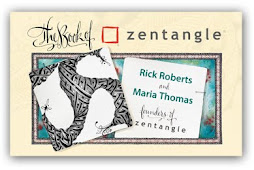Maria writes. . .
Most of you know that I am a passionate picture framer. My family had a frame shop/art supply store/gallery years ago. It was there that I learned the importance and value of good presentation of one's art.
I continue to marvel at the moulding designs and textures, the colors and subtle details. Working at "Chamberlain's" (the name of our store) was like working at a candy store (that is, if I actually did like candy, which I don't, so maybe I should say "was like working at an Italian restaurant". . . but, I digress).
Many days were spent planning the framing and matting of my works (mostly calligraphy, some water colors) and I had the luck of being able to choose pretty much anything. But I did not abuse this and I work well with found objects. I would use the bits and pieces of partial mats and old frame mouldings and antique frames found at yard sales, and see what would happen. I would create hand-painted borders on my mats, with multiple layers of whites and ecru mats, creating a deep, lush presentation. Sometimes I would add small strips of hand-marbled paper in an old-world fashion. But, more often than not, it was the hand-painted ones that our customers asked for.
If I were to describe them today, it would be "Zentangle-style French mat" done with brush and water color. Here are two examples from BZ (before Zentangle). This first one is a frame I did for tapestry piece that I found converted into a pillow.
This second one, of Noah, Molly and Martha, I did when Molly graduated from college:
Such fun. Of course now, I just tangle away!
If you can tangle . . . you can border.
Rick comments:
It's neat to notice the seed forms of mooka and crescent moon in Maria's bordering on those mats.
There are a few ways you can go about this, with rulers, pencils and erasers; but come on . . . you guys know how I feel about those!
Let's try (just this once, I promise) in a more freeform style.
I had some pre-cut 8 x 10 mats, hand drew a (rather wobbly) line about 1/4" from the inside cut.
Then another subtly-wobbled line about 1/2" out from the first. (Of course this could be smaller or bigger, depending on the size of your mat.) You have created your "String" for your border.
You can tangle it a couple of different ways. In this example, (you can see I began with brown ink so you can see it later) I started by drawing a few simple
mookas around leaving spaces, not worrying about the spaces being perfectly even.
Then I added some
punzel next to each
mooka, then some
tripoli next to each
punzel . . . etc. When everything seems to be filling nicely, I finish it off filling the odd spaces with
perfs or
printemps ("spring" shaped spirals), a bit of striping . . . and
voila: border!
Next is the frosting on the cake. With a pencil, grey marker or a brush with some watery gray color, shade the outer edges, both sides, and watch your border pop.
So professional of you! The wobbly-ness disappears and is replaced with a softness that a ruler can only dream of.
This works every time.
These borders are really cool for framing:
- favorite photos or pieces of photos
- a special postage stamp
- a beautifully pressed flower or leaf
- a feather or shell
- a page from an old book of poetry
- an old spoon or fork (that one cannot even figure out what it must have been used for. . .)
- a lovely old brooch with the pin missing (what will I ever do with this?) that your mom wore often
- a poignant greeting card from someone special
- a lock of baby hair
or. . maybe even, no wait, wait! how about . . . a Zentangle!
So dear tanglers, have some fun with this. Even if you don't frame them. . . just make your border on a Zentangle tile and clip a photo, getting rid of the "too much background" that we all are guilty of in our photos. . . . and you have a fabulous piece to cherish or
give away!
AND, speaking of give away . . . let's hear what you have to add to this and I would love to give away the mat in this blog (8 x 10") to one of our commenters. Be sure I can contact you somehow!
Supplies used:
- Sakura® Micron™ black 01 and brown 05
- Fabrico® cool gray marker
- Strong black tea. I used this, not only on the white Zendala, but also over the white Gelly Roll® ink to add some warm tones ever so
- Sakura white Gelly Roll™
- mat
- Zentangle Original tiles, black tiles and Zendala tiles
Click images for larger views.
































